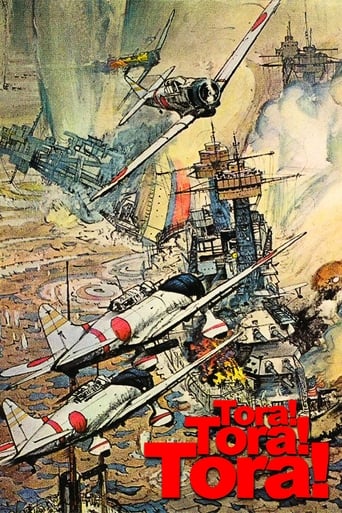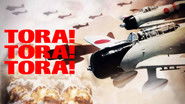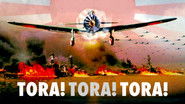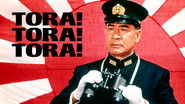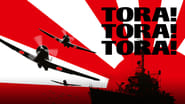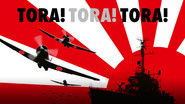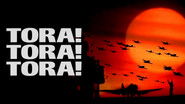JLRVancouver
I first saw "Tora Tora Tora" on my 12th B-day (when it first came out) and have seen it several times since. The movie has aged well and, compared to Michael Bay's abysmal "Pearl Harbour" (2001), demonstrates the effectiveness of practical effects over CGI (although the gap continues to narrow). The story starts slowly, following the meticulous Japanese planning as it parallels the American blunders, misreads and delays, that ultimately lead to the (unintentional) 'sneak attack' on Pearl Harbour. The transition between the planning and the attack scenes is the weakest part of the movie, played almost as a comedy, with befuddled Americans staring up at Japanese aircraft but just 'not getting it" - scenes which do not ring true, as these were trained soldiers and sailors, and the Americans were suspicious of the Japanese. The attack sequences are excellent with lots of well executed pyrotechnics, especially of mock-up P40s exploding. Multiple cameras were used, so there is a bit of a sense of déjà vu as you see the same plane blowing up from different angles (the P40 with its nosecone shot off is the most obvious example). The backstory (told elsewhere) about how one of motorised P40 models went out of control is a good cautionary tale about the dangers of filming battle scenes with full scale effects. Not all of the cast were professional actors and it sometimes shows, the secondary dialogue is weak in places, and some of the back-projection (e.g. the flying lesson scene) is not particularly good, but overall, "Tora Tora Tora" is a great war movie with enough history mixed in with the explosions to make it worth watching on multiple levels.
cinemajesty
"Tora, Tora, Tora" opens with clean static shots on both ends, establishing the Japanese and U.S. American war parties in WW2. A film split in two directing parties on the U.S. American side Ruben Fleischer, known before for "Fantastic Voyage" (1966) and his interpretation on Jules Verne's "20,000 Leagues Under The Sea" (1954) and the Japanese Director due Kinji Fukasaku & Toshio Masudo, replacing Akira Kurosawa over creative differences. Unfortunately, we will never know, what a movie "Tora, Tora, Tora" might have been with Kurosawa in the directing chair, who became fed up with the studio policies and retreating to Japanese art-house again after an extraordinary run in the time period 1950 to 1965 with arguable cinematic masterpieces."Tora, Tora, Tora" is not a masterpiece. It has the stale fine crafted stain of a well-organized studio picture machine. Seen it again in 2017, it has surprisingly many parallels to the 2001 "Pearl Harbor" movie in the main theme of attacking the named after Hawaiiean harbor city. Afro-American takes a machine gun stand on U.S. marine destroyer before the ship gets dismantled by so-called magic bomb, failing counter-strike of U.S. air-force due to Japanese air-raid, where an entire airfield gets shot to pieces with unprotected Air Force properties on the ground and concluding with infamous a Kamikaze-Action of Japanese pilot flying into an airfield hangar. It sounds spectacular and it still is, due to the pyro-technicians, who had to work without any digital extensions of the frame.The air-raid sequence lasts nearly 26mins+ of the film's running time. The editorials had been neatly arranged. Nevertheless at today's standards the film lacks cinematographic vision, for example missing hand-held immersive shots to break the audience's comfort zone. In "Tora, Tora, Tora" the coverage always keeps the spectator in safe distance of the action, counting on wide shot pyro-technical arrangements, which have at times a fine-composed cinema-scope canvas in color, angle and perspective balance. Furthermore exceptional stunt men work with human interactions close to blazing fire fronts and explosions are another viewing worth while. But then again the at running time mark 02h 03mins 20sec (PAL-version) immerging air battle between U.S. & JP jets missing camera movements close to outer shell of the planes, reminiscing to "Grand Prix" (1966) and "Le Mans" (1970), which came before.The international directors of "Tora, Tora, Tora" played it conservatively save with their interpretation of such a out-of-proportion historical event at a time when Directors as John Schlesinger and William Friedkin were already daring into new artful cinematic dimensions with "Midnight Cowboy" (1969) and "French Connection" (1971), which was probably one of the reason that such a director as Akira Kurosawa had to leave the project. When it comes to true event war movies, especially on such a delicate matter it might have been a bridge too far for a wide release picture. Nevertheless it is a movie for the lovers of the ordered and rigid world of military operations. 2nd unit miniature work of submarine, destroyers and aircraft carrier with live-action documentary footage seamlessly integrate into the editorial. Furthermore Jerry Goldsmith's score on the movie's soundtrack agrees with the picture."Tora, Tora, Tora" has the common pace of a 70s viewing a habits. There are no risks taken. The clearest/cleanest shots win. The film has a nostalgia of an early hour low light film-grain emulsion, best witnessed at running time marker 1h 22mins 15sec with live-action footage of departing Japanese combat jets. Overall suspense of the picture is low due to the lack of inter-character conflicts. Quick inter-cut of General Marshall having a ride-out with horse in countryside. An Officer hesitates to call president of potential threads. Hand-written orders get hand-over in close to coffee drinking officers in a U.S. military bureau. Soldiers and their officers having a drink, dance, smoke on outdoor occasion, while Japanese taking rituals before Sunday morning's attack on December 7th 1941, pushing themselves with warrior cries and officers' ordered uniformed standing occasion.Despite that the cross-cutting of the U.S. and Japanese story lines work fluently. Japanese plan the attack of Pearl Habor as a gamble, while shallow written confrontations bug the U.S. officers, who are worrying on their position in the military machine, writing and receiving reports. Another straight cut to the Japanese chief strategist sitting in a darken-out room and officers having meal at long table. And when the harbor attack sequence is over, all what is left for the audience to witness is the desolated harbor sight after mayhem and destruction level high-rise on the U.S. sight, which might have treasured Hollywood's pathway for disaster movies of the 70s such as "The Poseidon Adventure" (1972) and "The Towering Inferno" (1974) and Coffee & Cigarettes smoking in another briefing room for the Japanese party, realizing that a war machine has been awaken, the sleeping giant towards the final consequence on August 8th 1945.© 2017 Felix Alexander Dausend
Geoffrey DeLeons
I just watched this movie (3rd or 4th time) again last night, and I was shocked to read that it was made in 1970. The sophistication of the screenplay is such that I thought it was from the mid-eighties, at least. The multitude of human, social factors involved in the U.S. failure and the Japanese (partial) success is given due consideration in the movie, as scenes with numerous political and military figures on both sides characterize the forces involved that lead inevitably to the attack. The screenplay is thorough, relentless and intelligent. To make-simple and accessible a very tangled situation with many cross-currents and short circuits is a testament to the skill of the producers of this movie. I was very impressed that the producers were able to somehow manage scenes with period-correct ships and aircraft. I did not know there were that many Zero's, Kate's and P-40B's airworthy back in 1970. I'm not sure how they did it. The scenes on the runway are some of the most thrilling I have ever seen in cinema. I need to say that I think more time should have been devoted to the sailors trapped below decks. I know there was a fleeting scene where-in someone yelled "The hatch is jammed", but there should have been more, considering, perhaps especially, the travail of those trapped inside the U.S.S. Oklahoma and the massive effort conducted to liberate them. An important movie, both historically and cinematically.
david-sarkies
The thing that stands out in this movie is the half hour long battle of Pearl harbour. This movie is a historical recreation of the Japanese attack on Pearl Harbour and it is incredibly close to the actual events. It more of a documentary done in the way of a film. The thing is that there are quite a few issues which are of historical significance in this film and that are explored. They are the relationship between the United States and Japan, the US unwillingness to go to war, and the arrogance of the United States into believing that nobody would even consider attacking them, and finally how the people at the top did not realise the extent of the threat while the people at the bottom could inevitably see it coming.The first time I saw this movie was in year 11 during Modern History. The thing that stuck out was the length of the attack on Pearl Harbour, and it was really cool. I remember this one sailor firing this huge machine gun at Japanese planes. Another scene is where a Japanese plane flies over a parade ground, and the reaction of the commander there is that it was some American fly-boy being funny - that is until it drops a bomb.The issue behind the events were in regard to dominance of the Pacific Rim. The Japanese wanted to establish a Pacific Empire, but the problem was that America considered the Pacific Ocean to be theirs, and there was no room for the two super powers to share. The Japanese were feeling pressured by the Americans with their war in China, especially since they ceased trading with them forcing them to either push the Americans out of the picture or to move into South-East Asia. They chose the second option but the Americans reacted very badly to that so they decided that they needed to move on the Americans.The thing that gets me is that throughout the movie we see the Americans as being the good guys and the Japanese as being the facists. What we do not see is the way that the Americans treated the Negroes, the Mexicans, or even the Indians. This was not a war of good against evil, but rather two superpowers fighting over something that they did not want to share. The Americans condemned Japan for its actions in China, yet no mention of the American's actions in their land against the Indians - first of all invading their territories and then displacing them into reserves and even assimilating them. The Negro issue regarding slavery had been sorted out, but they were still considered second class citizens. The American Secretary of Defense condemned the Japanese Ambassador for his nation's actions and made him look like a bad boy, but it is more like a bully forcing a weaker kid to admit that he is the bad person and that the bully is the good person. In my books, nobody is good or bad, but we are all as corrupt as everybody else.The next issue I will address is the belief that America would not be attacked, which I will combine with the difference between the generals and the people at Pearl Harbour. Constantly we are shown how nobody expects Japan to attack. The first event is when the planes in the airbase are grouped togeather to prevent sabotague, yet wise commanders realise that this is bad because an attack could wipe them all out - which it did. Another incident is when the planes are spotted on Radar, but they are ignored because they must be American planes. Nobody was expecting that Japan would make such a bold move, though evidence pointed out that it would happen. The Americans had cracked their codes and were receiving all of the messages. They knew that a fleet had moved out but did not act on it. They had even sunk a submarine just outside of Pearl Harbour, but considered it to be nothing, especially since there was no hard evidence. This couples with the unwillingness of the US to go to war that they would rather ignore the signs in hope that they would not be dragged into a bloody conflict.The one thing that slightly irritated me is that President Roosevelt is never shown (though neither is the Japanese Emperor). It is as if the president is some sort of god symbol who cannot be portrayed on screen. It is probably not that, but that they did not want to go to the effort of trying to find somebody who looks like Roosevelt. It also gives the impression of the generals running the show and that the president simply says yes or no on the really important decisions, but only receives the information that the general wants them to know.This is a good movie. It is historically accurate and as such is a great movie to watch to try and understand the events leading up to Pearl Harbour. It is decidedly pro-American but that is what one should expect when approaching an American movie.
